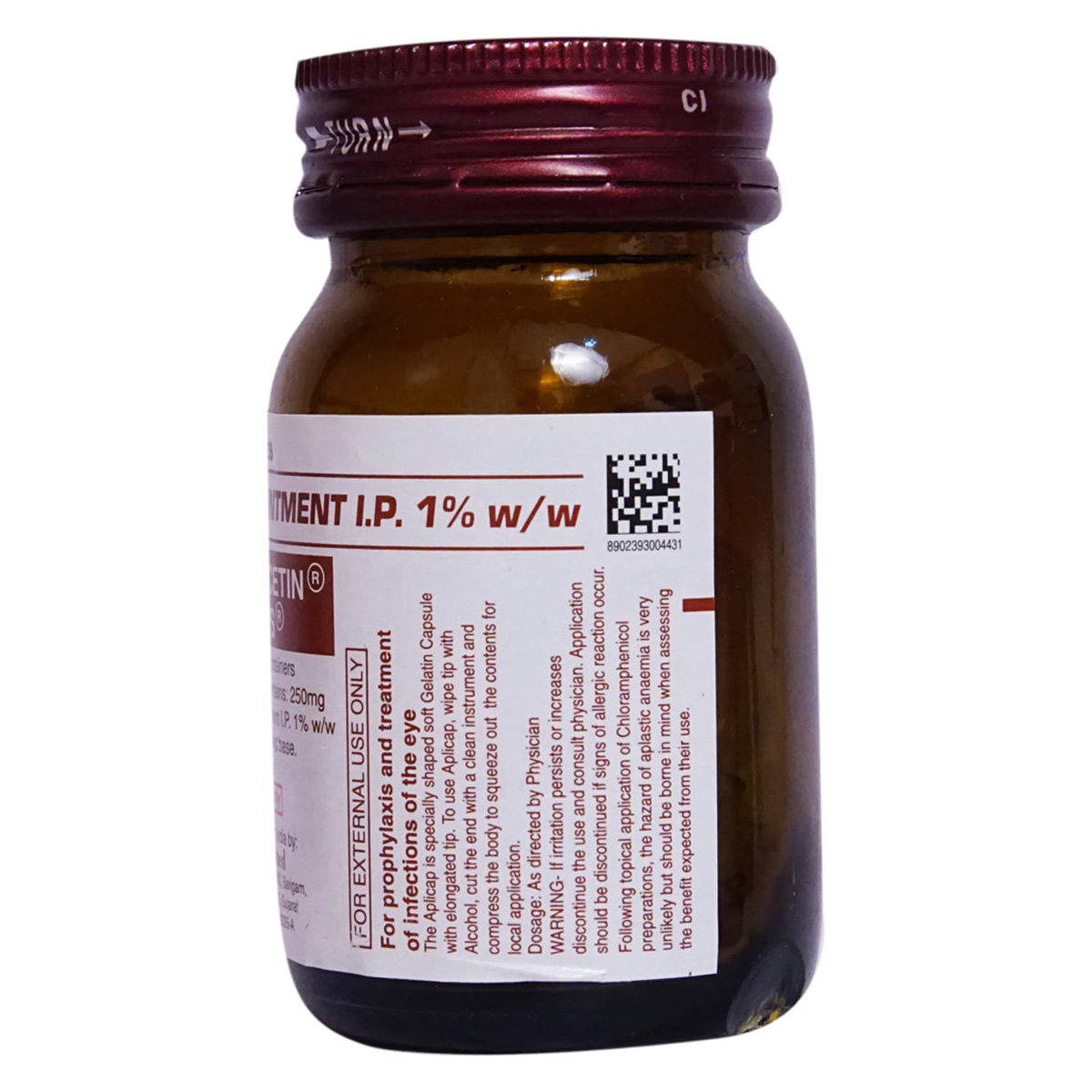Chloramphenicol Eye Ointment 1's


MRP ₹93.5
(Inclusive of all Taxes)
₹14.0 Cashback (15%)
Provide Delivery Location
Online payment accepted
 Prescription drug
Prescription drugWhats That
Composition :
Manufacturer/Marketer :
Consume Type :
Return Policy :
Expires on or after :
About Chloramphenicol Eye Ointment
Chloramphenicol Eye Ointment belongs to the group of medicines called antibiotics used to treat bacterial infections of the eye. Bacterial eye infection occurs when harmful bacteria invade any part of the eye, such as the eyeball, conjunctiva, or cornea.
Chloramphenicol Eye Ointment contains Chloramphenicol, which works by preventing the synthesis of nutrients essential for bacterial survival. Thus, it kills bacteria and treats bacterial eye infections.
Sometimes, you may experience side effects such as mild eye irritation, stinging sensation, and temporary blurred vision. Most of these side effects do not require medical attention and will resolve gradually over time. However, you are advised to talk to your doctor if the side effects persist or worsen.
Consult your doctor if you are pregnant or breastfeeding. Chloramphenicol Eye Ointment should be used in children above 2 years only if prescribed by the doctor. Avoid touching the tip of the container as it may contaminate the contents. Keep your doctor informed about your health condition and medications to prevent side effects/interactions.
Uses of Chloramphenicol Eye Ointment
Directions for Use
Medicinal Benefits
Chloramphenicol Eye Ointment belongs to the group of medicines called antibiotics used to treat bacterial infections of the eye. Chloramphenicol Eye Ointment contains Chloramphenicol, which works by preventing the synthesis of nutrients essential for bacterial survival. Thus, it kills bacteria and treats bacterial eye infections.
Storage
Drug Warnings
Do not use Chloramphenicol Eye Ointment if you are allergic to any of its components. Inform your doctor if you or your family member has had problems with their blood or bone marrow if you have visual disturbances, severe pain in the eye, sensitivity to light, glaucoma, eye injury, dry eyes, kidney or liver problems, a sensation of having a foreign body in the eye, eye inflammation, if the eye looks cloudy or if the coloured part of the eye looks unusual, or if you have/had eye surgery. Consult your doctor if you are pregnant or breastfeeding. Do not wear contact lenses during the course of treatment with Chloramphenicol Eye Ointment and for 24 hours after the last dose.
Drug-Drug Interactions
Drug-Drug Interactions
Login/Sign Up
Taking Flibanserin with Chloramphenicol 1% Eye Ointment may significantly increases the blood levels of flibanserin
How to manage the interaction:
Taking Chloramphenicol 1% Eye Ointment with Flibanserin is not recommended, but can be taken together if prescribed by a doctor. However, consult your doctor if you experience dizziness, lightheadedness, and fainting. Do not discontinue any medication without consulting a doctor.
Taking lomitapide with Chloramphenicol 1% Eye Ointment can significantly increase the blood levels of lomitapide.
How to manage the interaction:
Taking Chloramphenicol 1% Eye Ointment with Lomitapide is not recommended, but can be taken together if prescribed by a doctor. However, consult your doctor if you experience fever, chills, joint pain or swelling, unusual bleeding or bruising, skin rash, itching, loss of hunger, weakness, nausea, vomiting, dark colored urine, light colored stools, and yellowing of the skin or eyes. Do not discontinue any medications without consulting a doctor.
Taking Chloramphenicol 1% Eye Ointment with triazolam can increased the effects of Chloramphenicol 1% Eye Ointment.
How to manage the interaction:
Taking Triazolam with Chloramphenicol 1% Eye Ointment is not recommended, but can be taken together if prescribed by a doctor. In case you experience any unusual symptoms, consult a doctor. However, if you experience any unusual symptoms contact your doctor. Do not discontinue any medications without consulting a doctor.
When Pimozide is taken with Chloramphenicol 1% Eye Ointment, the amount of Pimozide in the blood increases which increase the risk of an irregular heart rhythm and other side effects.
How to manage the interaction:
Although taking Chloramphenicol 1% Eye Ointment and Pimozide together can evidently cause an interaction, it can be taken if your doctor has suggested it. However, if you experience dizziness, lightheadedness, fainting, shortness of breath contact your doctor right away. Do not stop using any medications without first talking to your doctor.
Taking Naloxegol and Chloramphenicol 1% Eye Ointment can significantly increase the blood levels of naloxegol that may increase the risk of side effects.
How to manage the interaction:
Although taking Chloramphenicol 1% Eye Ointment and Naloxegol together can evidently cause an interaction, it can be taken if your doctor has suggested it. However, if you experience sweating, runny nose, or abdominal pain contact your doctor know right away. Do not stop using any medications without a doctor's advice.
Taking Chloramphenicol 1% Eye Ointment and Hydrocodone can significantly increase the blood levels of cariprazine.
How to manage the interaction:
Although taking Chloramphenicol 1% Eye Ointment with Hydrocodone can possibly result in an interaction, it can be taken if your doctor has advised it. If you're having any of these symptoms like dizziness, lightheadedness, headache, flushing, fainting, and heart palpitations feeling tired, having trouble moving, difficulty swallowing or having seizures, it's important to let your doctor know. Do not stop using any medications without a doctor's advice.
Co-administration of acalabrutinib with Chloramphenicol 1% Eye Ointment can significantly increases the blood levels of acalabrutinib.
How to manage the interaction:
Although there is a interaction between Chloramphenicol 1% Eye Ointment and Acalabrutinib, but it can be taken together if prescribed by your doctor. However, if you experience symptoms like paleness, fatigue, dizziness, fainting, unusual bruising or bleeding, fever, chills, diarrhea, sore throat, muscle aches, shortness of breath, red or inflamed skin, body sores, and pain or burning during urination, call your doctor. Do not stop using any medications without talking to a doctor.
Taking Chloramphenicol 1% Eye Ointment and Guanfacine may significantly increase the blood levels and effects of guanfacine.
How to manage the interaction:
There may be a possibility of interaction between Chloramphenicol 1% Eye Ointment and Guanfacine, but it can be taken if prescribed by a doctor. It's important to keep an eye on your blood pressure and heart rate. However, if you experience symptoms such as drowsiness, dizziness, lightheadedness, fainting, headache, palpitations consult a doctor. Do not discontinue any medications without consulting a doctor.
When Everolimus is taken with Chloramphenicol 1% Eye Ointment that may increase the risk of side effects.
How to manage the interaction:
Co-administration of Chloramphenicol 1% Eye Ointment with Everolimus can result in an interaction, but it can be taken if a doctor has advised it. If you experience any unusual symptoms like persistent cough, fever, chills, mouth ulcers, paleness, unusual bruising, bleeding or blood in stools or urine, it's important to contact a doctor. Do not stop using any medications without talking to a doctor.
Taking Clozapine with Chloramphenicol 1% Eye Ointment may increase the risk of infections.
How to manage the interaction:
Although there is a interaction between Clozapine and Chloramphenicol 1% Eye Ointment, but it can be taken if prescribed by a doctor. However, if you experience fever, chills, diarrhea, sore throat, muscle aches, shortness of breath, blood in phlegm, red or inflamed skin, body sores, and pain or burning during urination contact your doctor right away. Do not stop using any medications without a doctor's advice.
Drug-Food Interactions
Drug-Food Interactions
Login/Sign Up
Diet & Lifestyle Advise
- Wash your hands regularly. Avoid touching the eyes with dirty hands.
- Avoid rubbing the eyes.
- Avoid sharing eye makeup such as eyeliner, mascara or kohl.
- Always use clean towels or tissues to wipe your eyes and face.
- Regularly wash and change the pillowcases.
- If you wear contact lenses: Clean and replace contact lenses more often. Never share contact lenses. Remember to wash your hands before inserting and after removing the contact lens.
- Avoid staring at digital screens for longer durations. Rest your eyes every 20 minutes.
- Blink regularly as it helps spread hydrating substances such as mucus and tears across the eyes.
Side Effects of Chloramphenicol Eye Ointment
- Mild irritation
- Stinging sensation
- Temporary blurred vision
Habit Forming
Therapeutic Class
All Substitutes & Brand Comparisons
RX
Out of StockExphenicol Eye Onitment
Zee Laboratories Ltd
₹1.5
(₹0.27/ 1gm)
99% CHEAPERRX
Chloromphenicol Applicaps 100's
Soft Medicaps Ltd
₹92
(₹0.83 per unit)
99% CHEAPERRX
Out of StockChloromycetin Aplicap 50's
Pfizer Ltd
₹106
(₹1.87 per unit)
97% CHEAPER
Product Substitutes
Author Details
We provide you with authentic, trustworthy and relevant information
Drug-Diseases Interactions
Drug-Diseases Interactions
Login/Sign Up
FAQs
Chloramphenicol Eye Ointment works by preventing the synthesis of essential nutrients for bacterial survival. Thus, kills the bacteria and treats bacterial eye infections.
To treat your condition effectually, continue using Chloramphenicol Eye Ointment for as long as your doctor has prescribed it. Consult your doctor if you have any difficulty while using Chloramphenicol Eye Ointment.
Chloramphenicol Eye Ointment might temporarily cause blurred vision. So, avoid driving or operating machinery until your vision is clear.
Do not wear contact lenses during the course of treatment with Chloramphenicol Eye Ointment and for 24 hours after the last dose. Using spectacles and avoiding wearing contact lenses is recommended until the infection is cleared.
Consult your doctor if you are due to have eye surgery or if you have had eye surgery in the past six months, as Chloramphenicol Eye Ointment may slow corneal wound healing.
Drug-Drug Interactions Checker List
- CHYMOTRYPSIN
- METHOTREXATE
- AZATHIOPRINE
Disease/Condition Glossary
Bacterial eye infections: Bacterial eye infection occurs when harmful bacteria invade any part of the eye, such as the eyeball, conjunctiva, or cornea. Symptoms of an infection include red eye, pain, discharge, watery/dry eyes, swelling, itching, and sensitivity to light. The common bacterial eye infections are conjunctivitis, stye, and keratitis. Conjunctivitis (pink eye) is the infection/inflammation of the conjunctiva (white part of the eye) and the inner eyelid. A stye is a bump on the eyelid or base of eyelashes. Keratitis is the inflammation of the cornea. It is a common problem in people who wear contact lenses.

Have a query?
Buy best Ocular products by
Entod Pharmaceuticals Ltd
Ajanta Pharma Ltd
Sunways (India) Pvt Ltd
Sun Pharmaceutical Industries Ltd
Cipla Ltd
Micro Labs Ltd
Allergan Healthcare India Pvt Ltd
Intas Pharmaceuticals Ltd
Raymed Pharmaceuticals Ltd
Nri Vision Care India Ltd
FDC Ltd
Jawa Pharmaceuticals India Pvt Ltd
Indoco Remedies Ltd
Sapient Laboratories Pvt Ltd
Senses Pharmaceuticals Pvt Ltd
Centaur Pharmaceuticals Pvt Ltd
Neomedix Healthcare India Pvt Ltd
Aromed Pharmaceuticals
Optho Remedies Pvt Ltd
Aurolab
Austrak Pvt Ltd
Lupin Ltd
Mankind Pharma Pvt Ltd
Zivira Labs Pvt Ltd
Optho Pharma Pvt Ltd
Synovia Life Sciences Pvt Ltd
Akumentis Healthcare Ltd
Eyekare
His Eyeness Ophthalmics Pvt Ltd
Protech Remedies Pvt Ltd
Runyon Pharmaceutical Pvt Ltd
Alcon Laboratories Inc
Syntho Pharmaceuticals Pvt Ltd
Alembic Pharmaceuticals Ltd
Bell Pharma Pvt Ltd
Klar Sehen Pvt Ltd
Sentiss Pharma Pvt Ltd
Irx Pharmaceuticals Pvt Ltd
Optho Life Sciences Pvt Ltd
Phoenix Remedies Pvt Ltd
Alkem Laboratories Ltd
Doctor Wonder Pvt Ltd
Hicare Pharma
Ipca Laboratories Ltd
Neon Laboratories Ltd
Okulus Drugs India
Pharmtak Ophthalmics (I) Pvt Ltd
Berry & Herbs Pharma Pvt Ltd
Glow Vision Pharmaceuticals
Kaizen Drugs Pvt Ltd
Choroid Laboratories Pvt Ltd
Indiana Opthalamics Pvt Ltd
Optica Pharmaceutical Pvt Ltd
Pharmatak Opthalmics India Pvt Ltd
Samarth Life Sciences Pvt Ltd
Vibgyor Vision Care
Mofon Drugs
Novartis India Ltd
Pharmia Biogenesis Pvt Ltd
Zydus Cadila
Appasamy Ocular Devices Pvt Ltd
Leeford Healthcare Ltd
Medivision Pharma Pvt Ltd
Orbit Life Science Pvt Ltd
X-Med Royal Pharma Pvt Ltd
Zee Laboratories Ltd
Aarma Laboratories
Guerison MS Inc
Laborate Pharmaceuticals India Ltd
Xtas Pharmaceuticals
Accurex Biomedical Pvt Ltd
Blucrab Pharma Pvt Ltd
Does Health Systems Pvt Ltd
Flagship Biotech International Pvt Ltd
Lavue Pharmaceuticals Pvt Ltd
Nutrilis Healthcare Pvt Ltd
Ursa Pharm India Pvt Ltd
Vee Remedies
Vyonics Health Care India Pvt Ltd
Warren Pharmaceuticals Pvt Ltd
Abbott India Ltd
Accvus Pharmaceuticals
Akums Drugs & Pharmaceuticals Ltd
Cadila Healthcare Ltd
Carevision Pharmaceuticals Pvt Ltd
Dey's Medical Stores (Mfg) Ltd
East West Pharma India Pvt Ltd
Eyedea Pharmaceuticals Pvt Ltd
Nimbus Healthcare Pvt Ltd
Ocuris Pharmaceuticals Pvt Ltd
Sherings Pharmaceuticals
Tarks Pharmaceuticals Pvt Ltd
Vcan Biotech
Vision Medilink
Aice Health Care Pvt Ltd
Appasamy Pharmaceuticals Pvt Ltd
Asperia Lifescience Pvt Ltd
Beatum Healthcare Pvt Ltd
East India Pharmaceutical Works Ltd
Grevis Pharmaceutical Pvt Ltd
Alcohol
Consult your doctor
It is not known whether alcohol interacts with Chloramphenicol Eye Ointment. Please consult your doctor.
Pregnancy
Caution
Please consult your doctor if you are pregnant before using Chloramphenicol Eye Ointment; your doctor will prescribe only if the benefits outweigh the risks.
Breast Feeding
Caution
Please consult your doctor if you are breastfeeding before using Chloramphenicol Eye Ointment; your doctor will prescribe only if the benefits outweigh the risks.
Driving
Caution
Chloramphenicol Eye Ointment might temporarily blur your vision. So, avoid driving or operating machinery until your vision is clear.
Liver
Consult your doctor
Please consult your doctor if you have any concerns regarding the usage of Chloramphenicol Eye Ointment in patients with liver impairment.
Kidney
Consult your doctor
Please consult your doctor if you have any concerns regarding the usage of Chloramphenicol Eye Ointment in patients with kidney impairment.
Children
Consult your doctor
Please consult your doctor. Your doctor will decide the dose of Chloramphenicol Eye Ointment based on your child's age and condition. It is not recommended for use in children under two years of age.






_0.jpg?tr=q-85)

